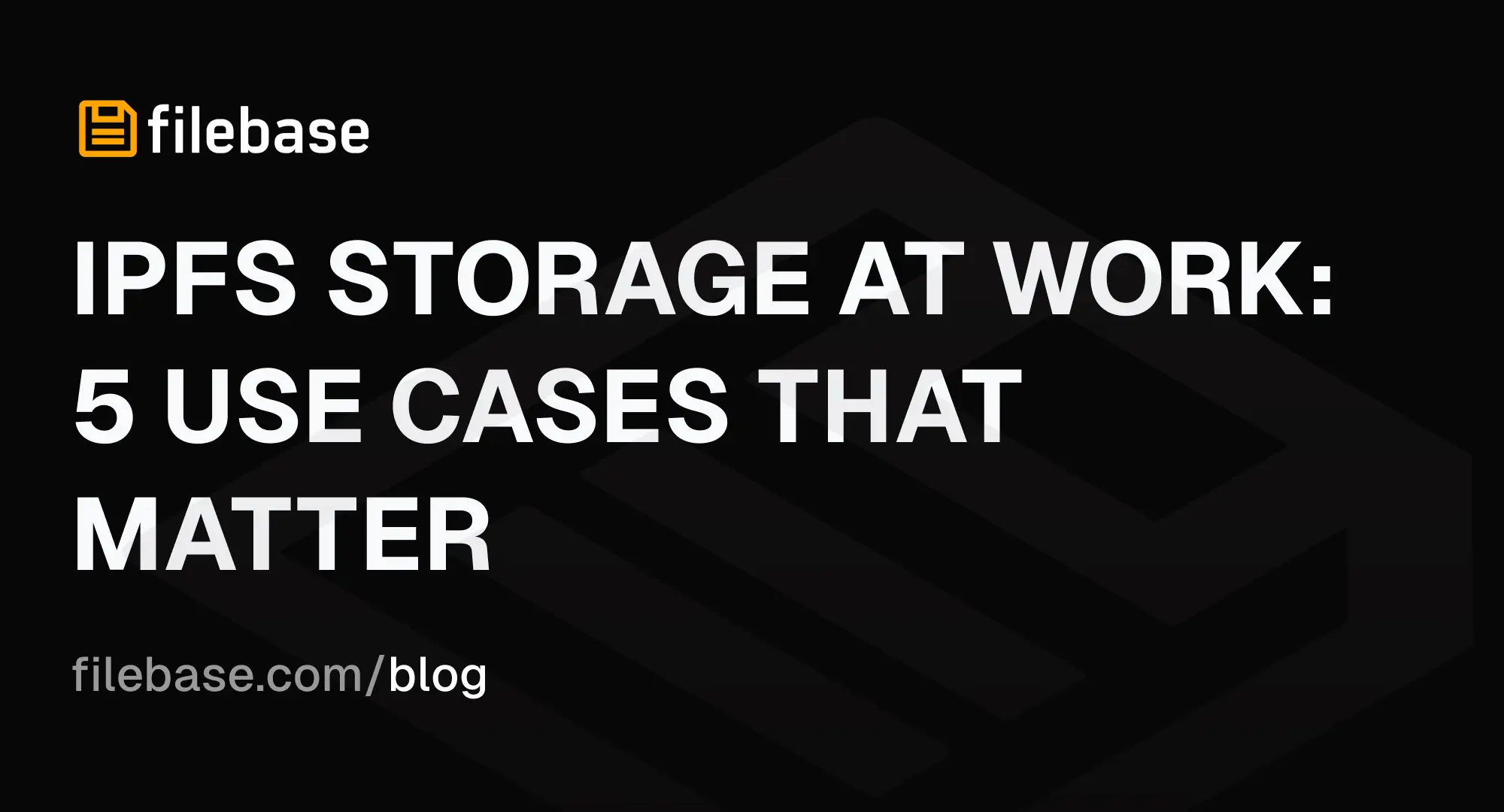IPFS Storage at Work: 5 Use Cases That Matter
Explore 5 real-world use cases where IPFS storage powers NFTs, dApps, research, video, and public data in 2025.

IPFS in the Real World
IPFS isn’t just for experiments or hacker projects. It’s becoming foundational infrastructure across production systems—from NFT marketplaces to government archives and decentralized research.
The protocol’s ability to deliver content immutably, independently of location, and without reliance on central servers is actually being used in meaningful ways. And this post isn’t about theory. These are five concrete, high-leverage use cases where IPFS is driving value right now.
Already familiar with how IPFS storage works? Great—this post skips the basics. If you want a refresher on the architecture or protocol design, start here.
Use Case 1: NFTs — Making Digital Ownership Permanent
In 2025, NFTs have matured beyond art drops and speculation. They're assets with real value—and that value depends on verifiable, permanent storage of metadata and media.
Platforms like OpenSea, Rarible, and Metaplex use IPFS to store full-resolution media off-chain while anchoring CIDs on-chain. Artists using services like NFT.storage now get immutability without ballooning gas costs.
Why it works:
- Content integrity is cryptographically verified (CID ≠ guesswork).
- Assets are censorship-resistant and not tied to any single platform.
- IPFS is cheaper than on-chain alternatives for media-heavy assets.
What’s still critical: Pinning. Without it, CIDs can technically vanish. Filebase and other pinning services help solve that.
Use Case 2: Decentralized Video Streaming
Centralized video platforms own your content and the distribution rails. In contrast, IPFS lets anyone stream, share, and serve video—without a central origin.
DTube and ipfs.video are early examples of P2P streaming. sanko.tv shows what’s possible with distributed live video currently backing up to IPFS.
Advantages in 2025:
- Popular videos are cached across nodes = faster for viewers.
- Bandwidth costs are distributed, not front-loaded.
Tradeoffs:
- Adaptive bitrate support is still evolving.
- Latency and peer availability affect stream reliability.
Still, it’s a leap toward decentralized, creator-owned delivery networks.
Use Case 3: Government Archives and Transparency
IPFS is being adopted by governments and public institutions for resilient, transparent data storage. The goal: make tamper-proof, censorship-resistant public data the default.
Real-world usage:
- Wikipedia mirrored on IPFS during bans (e.g., Turkey)
- Healthcare record archiving with encryption
- Tamper-proof election data or FOIA-style disclosures
IPFS aligns with open government principles—immutability, audit ability, and independence from any one host.
Considerations:
- Private IPFS networks may be needed for sensitive data.
- Content moderation is not built-in—security protocols must layer on top.
Use Case 4: Scaling dApps with Off-Chain Data
Decentralized applications are hitting real-world scale, and on-chain storage just isn’t feasible for anything beyond metadata. That’s where IPFS fits.
Today, devs use IPFS to:
- Store social posts, profile avatars, app config, and media
- Link off-chain files via on-chain CIDs
- Maintain data integrity without incurring high gas fees
IPFS + Filecoin creates a powerful combo: verifiable storage + incentive-backed persistence.
Apps on Ethereum, Solana, and L2s are relying on this architecture to reduce costs while keeping strong guarantees around trust.
Use Case 5: Scientific Research and Open Data Collaboration
Massive datasets. Global teams. Long-term archiving. Traditional scientific workflows aren’t built for this—but IPFS is.
Research projects in 2025 are using IPFS to:
- Version and verify climate model outputs
- Share brain imaging data across neuroscience labs
- Collaborate in the field with real-time, peer-synced datasets
Because content is addressed immutably, researchers can cite and reuse datasets without depending on a central server or static repository.
Security layers (encryption + access control) are essential here, but the base benefits—verifiability, resilience, open access—are unmatched.
Bonus: Hosting Static Sites on IPFS
Decentralized site hosting is no longer a fringe idea. Filebase makes it simple to deploy static sites to IPFS with human-readable URLs.
Why teams are using it:
- Resilient mirrors of documentation or political content
- No origin server = no single point of failure
- Reduced costs for content-heavy pages
For dynamic content, you still need serverless or hybrid infra—but for static pages, docs, and blogs, IPFS is reliable and censorship-resistant.
IPFS Is Delivering Where It Counts
These aren’t speculative features—they’re use cases running in the wild today. IPFS is solving real problems across storage-heavy industries where permanence, resilience, and verifiability matter.
Whether you're building dApps, running public infrastructure, or publishing datasets, IPFS is proving that protocols > platforms in 2025.
If you’re not thinking about content-addressed storage yet—this is the year to start.
Want to Learn More?
If you're exploring how to actually use IPFS storage in your projects—whether for NFTs, dApps, or decentralized publishing—check out our latest deep-dive:
👉 IPFS Storage Explained: How It Works
Reliable IPFS, Zero Headaches
Gateways, IPNS, and seamless pinning—all in one place. Try it now
Get Started For Free!